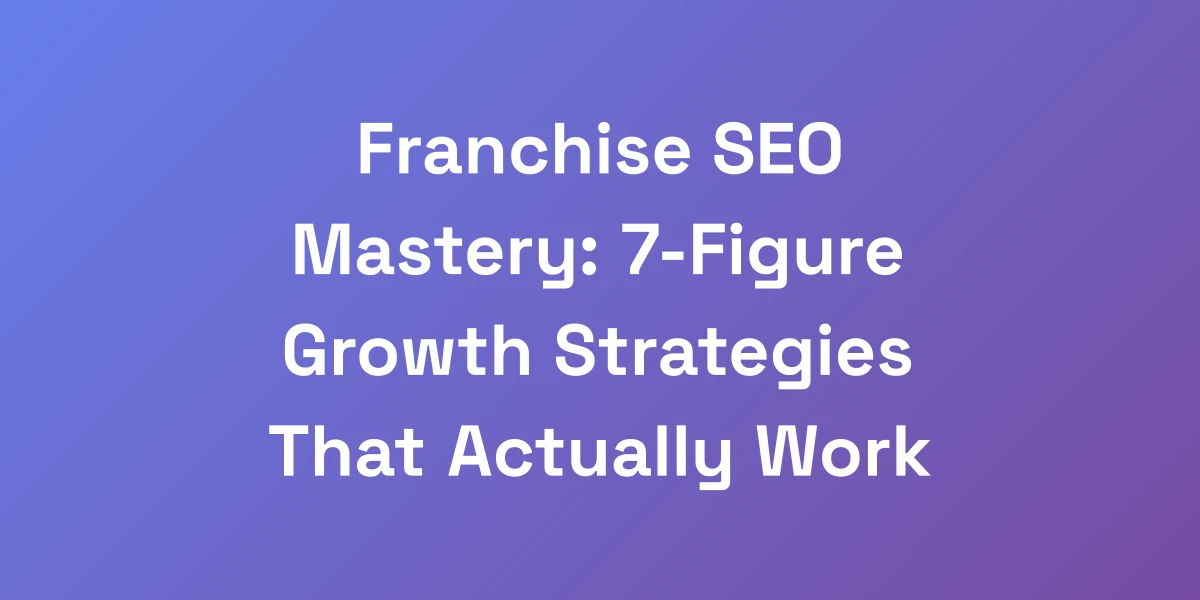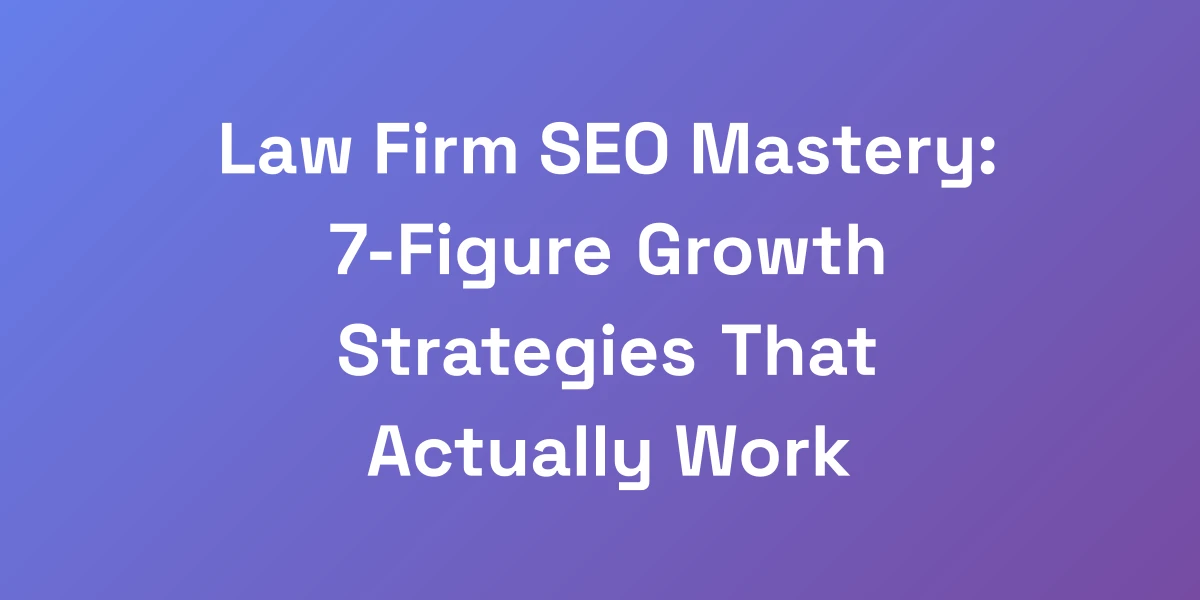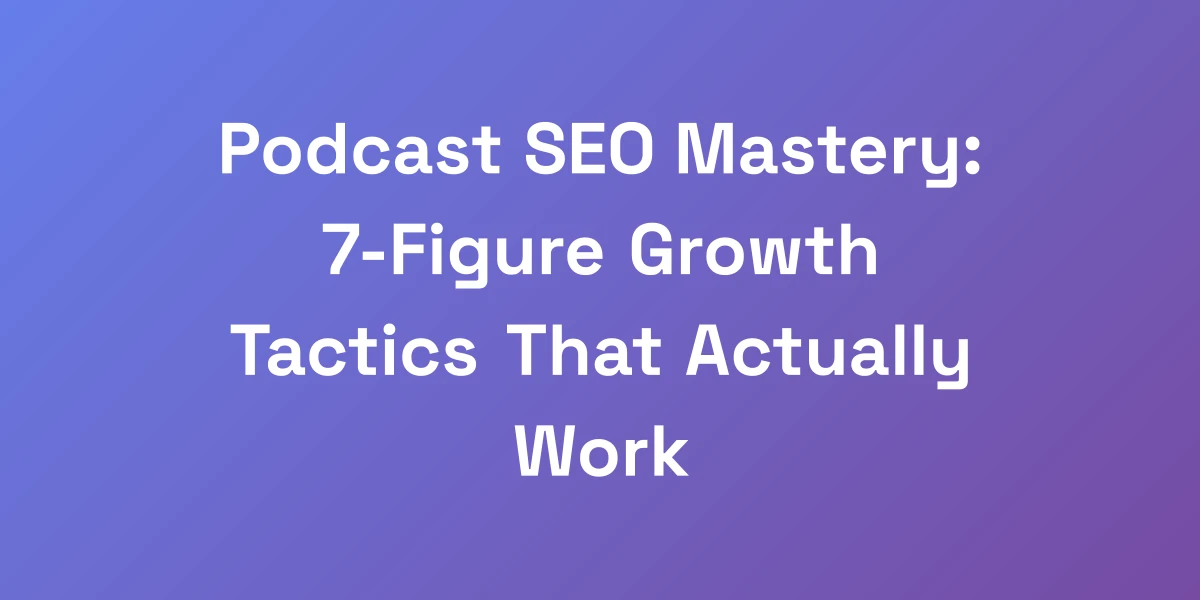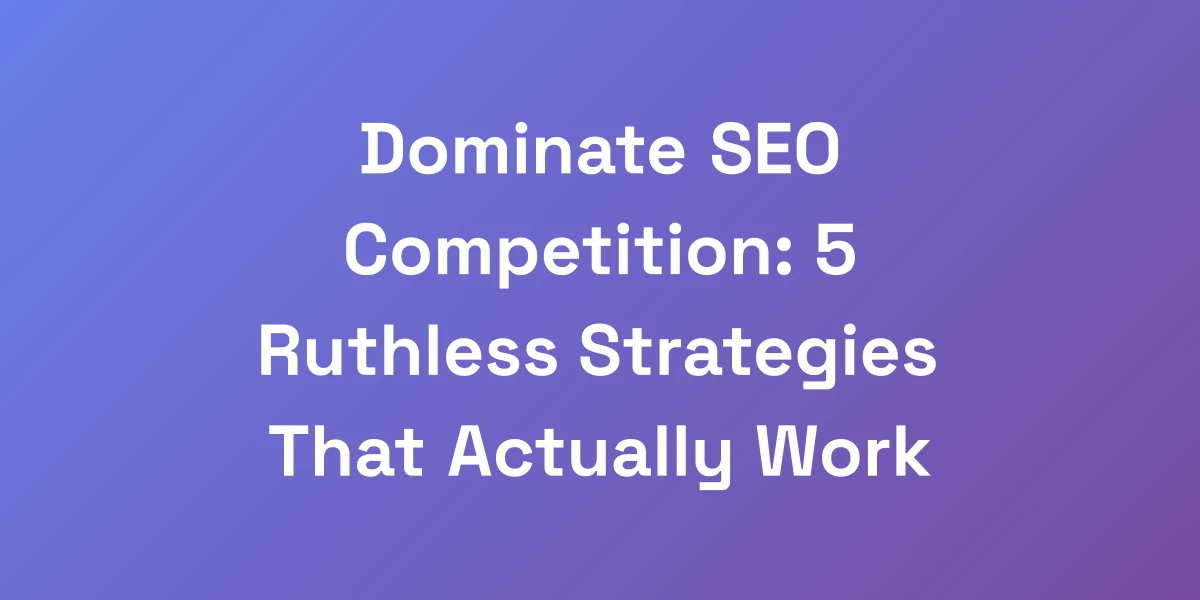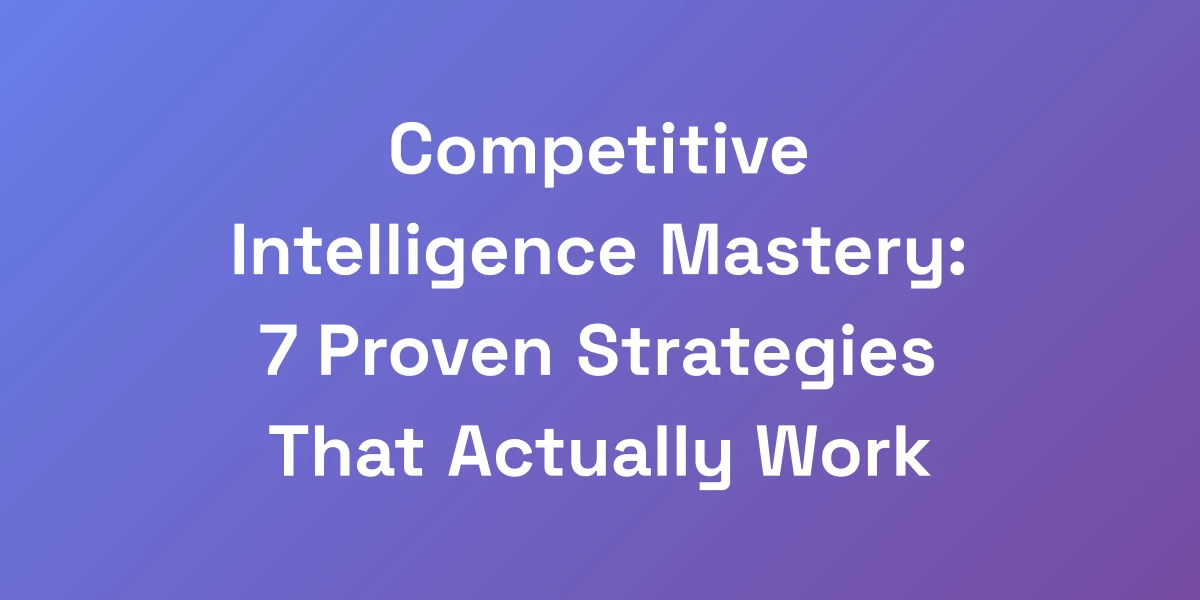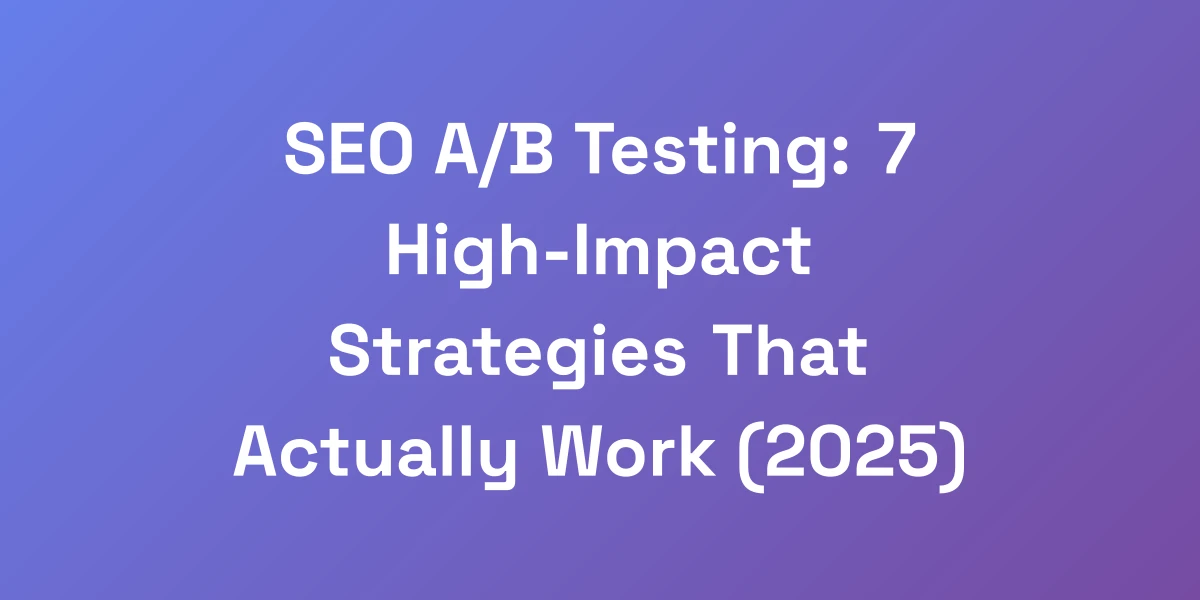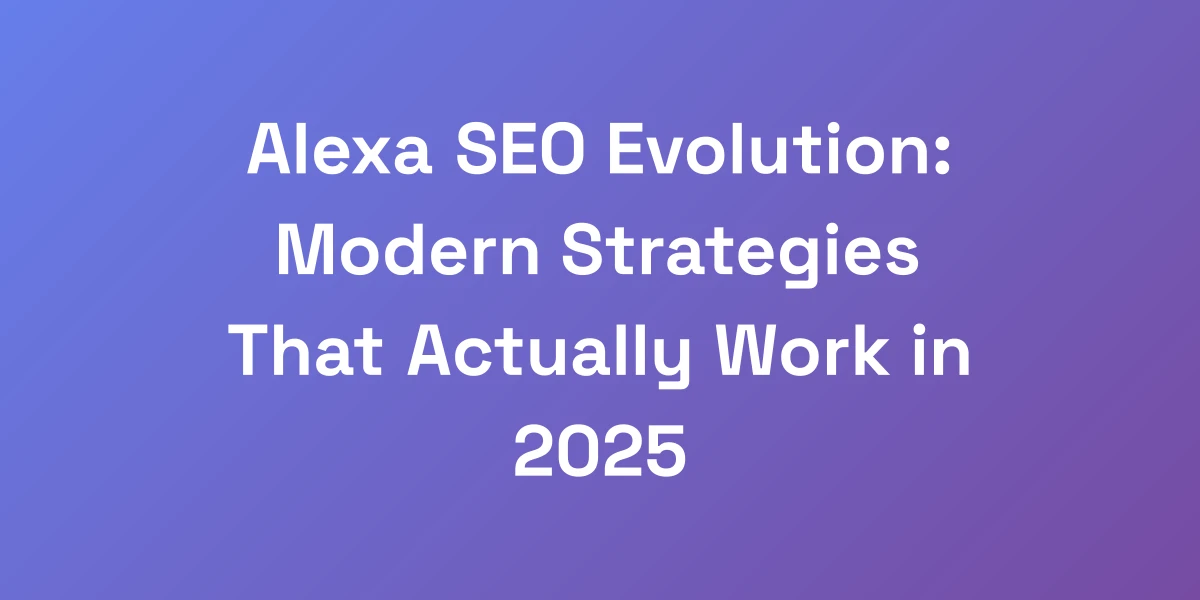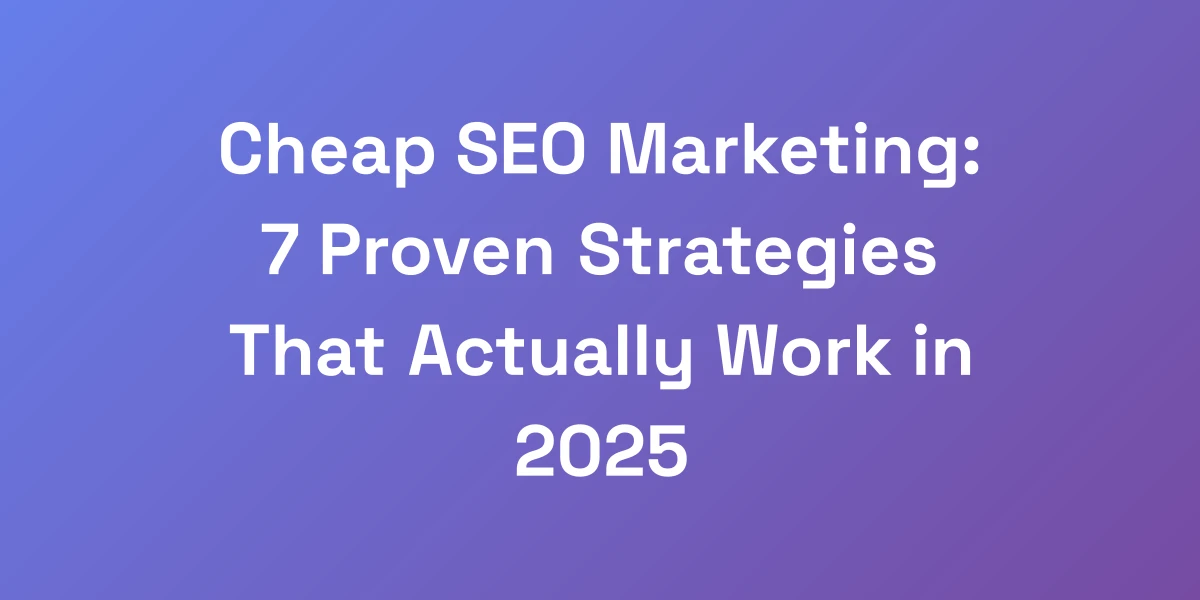
Enterprise SEO Mastery: 7-Figure Growth Strategies That Actually Work
Feb 28, 2025 | By [email protected]
Why Most Enterprise SEO Strategies Fail (And What Actually Works)
Let me be brutally honest here – 90% of enterprise SEO strategies are complete garbage. They’re built on outdated tactics that might work for small businesses but fall flat when scaled to enterprise level.
We’ve seen Fortune 500 companies hemorrhage millions in potential revenue because they treated enterprise SEO like a bigger version of small business SEO. The game changes entirely at enterprise scale.
What you’re about to learn are the exact strategies that helped our clients generate over $100M in additional revenue through enterprise SEO.
The Critical Differences Between Regular and Enterprise SEO
Think of regular SEO as driving a compact car around the block. Now, imagine taking a freight train down the highway – that’s enterprise SEO.
At its core, SEO for enterprise companies requires a different mindset. It’s not just about optimizing a handful of pages; we’re talking about managing millions of URLs, ensuring every single one aligns with your strategic goals.
Regular SEO can get bogged down by the basics, but enterprise SEO demands scalability, automation, and precision.
- Scale and Complexity: Enterprises deal with vast amounts of data and content that need consistent optimization.
- Resource Allocation: More teams and tools are required to handle the intricate processes, including best SEO platforms.
- Strategic Alignment: SEO strategies must align with overarching business objectives, not just online visibility.
Have you ever tried fitting a square peg into a round hole? That’s what regular SEO feels like at the enterprise level. It’s about customizing strategies to fit the unique demands of large-scale operations.
Common Enterprise SEO Pitfalls Costing Millions
Ever wondered why despite hefty investments, some SEO strategies fall flat? It’s usually because of common pitfalls that cost enterprises millions.
- Lack of Structured Data: Without proper schema markup, search engines can’t fully understand your content.
- Ignored Technical SEO: Overlooking site speed, mobile optimization, and crawl budget optimization can cripple your SEO efforts.
- Poor Content Strategy: Producing content without a strategic plan leads to wasted resources and minimal ROI.
- Inadequate Analytics: Not measuring the right KPIs results in misguided strategies and lost opportunities.
We’ve seen enterprises sinking millions because they overlooked these fundamental aspects. It’s time to avoid these costly mistakes and implement strategies that drive real growth.
The ROI-Focused Approach to Enterprise Search
When it comes to enterprise SEO, ROI isn’t just a metric; it’s the foundation of your strategy.
We adopt an ROI-focused approach by aligning SEO goals with business objectives. This means every optimization effort directly contributes to revenue growth.
- Revenue Tracking: Implementing systems to track how organic traffic converts into sales.
- Value-Based Metrics: Focusing on metrics like customer lifetime value and average order value.
- Strategic Allocation: Investing resources in high-impact areas that offer the best return.
Have you ever invested in something and never saw the returns? That’s why aligning SEO strategies with ROI is crucial. It ensures every action taken drives measurable business outcomes.
Case Study: How We Turned Around a Failing Enterprise SEO Program
Let’s talk about one of our clients, a Fortune 500 company struggling with their SEO.
They were pouring money into traditional SEO tactics, but their revenue wasn’t reflecting that effort. It was clear something was off.
We stepped in and conducted a comprehensive audit. What we found was a tangled web of technical SEO issues and a lackluster content strategy.
- Technical Overhaul: Improved site speed, mobile optimization, and fixed crawl budget issues.
- Content Revamp: Developed a strategic content plan focused on high-value keywords and user intent.
- Structured Data Implementation: Enhanced schema markup to improve search engine understanding.
Within six months, their organic traffic skyrocketed, leading to a 176% increase in revenue. This isn’t an isolated case; it’s a testament to the power of a well-executed enterprise SEO strategy.
Key Performance Indicators That Actually Matter
In the realm of SEO for enterprise companies, not all KPIs are created equal. It’s essential to focus on the ones that directly impact your bottom line.
- Organic Revenue: The total revenue generated from organic search traffic.
- Conversion Rate: The percentage of organic visitors who complete a desired action.
- Customer Lifetime Value (CLV): The total worth of a customer over their entire relationship with your business.
- Engagement Metrics: Metrics like bounce rate, average session duration, and pages per session.
Focusing on these KPIs ensures that your SEO efforts are driving tangible business outcomes, not just improving search rankings.
Building an Enterprise SEO Infrastructure That Scales
Here’s the truth about enterprise SEO infrastructure – if you can’t scale it, you’re dead in the water.
We’ve seen companies try to manage thousands of pages with tools designed for small businesses, and it’s like trying to drain the ocean with a coffee cup. Your infrastructure needs to handle exponential growth.
The framework we’re about to share has helped enterprises manage millions of pages while maintaining consistent growth in organic traffic and revenue. This isn’t theory – it’s battle-tested at scale.
Essential Enterprise SEO Tech Stack Components
Building a robust SEO infrastructure starts with the right tools. Here’s what you need in your stack:
- Advanced Analytics Tools: Tools like Google Analytics 360 and Adobe Analytics for deep insights.
- Enterprise SEO Platforms: Solutions like SEMrush, Ahrefs, and BrightEdge for comprehensive SEO platforms.
- Content Management Systems (CMS): Scalable CMS like WordPress Enterprise or Sitecore for managing vast amounts of content.
- Automation Tools: Workflow automation with tools like HubSpot or Marketo to streamline SEO processes.
- AI-Powered Tools: AI tools for content generation and optimization, such as GPT-4 based platforms.
Each component plays a critical role in ensuring your SEO efforts are efficient, scalable, and aligned with your business goals.
Automated Workflows That Save Hundreds of Hours
Imagine a world where repetitive SEO tasks are handled automatically. Sounds like a dream? It’s reality with automated workflows.
- Content Scheduling: Automate the timing of your content publications to ensure consistent output.
- Reporting: Set up automated reports that provide real-time insights without manual intervention.
- Link Building: Automate outreach processes to secure high-quality backlinks efficiently with enterprise SEO solutions.
By automating these workflows, we save enterprises hundreds of hours, allowing teams to focus on strategic initiatives that drive growth using enterprise SEO tools.
Data Integration and Analysis at Scale
Data is the backbone of enterprise SEO. Integrating and analyzing data at scale is non-negotiable.
- Unified Data Platforms: Use platforms like Tableau or Power BI to consolidate data from various sources.
- Big Data Analytics: Leverage big data tools to process and analyze vast amounts of SEO data.
- Real-Time Dashboards: Implement dashboards that provide real-time insights into your SEO performance.
With integrated data systems, we gain a 360-degree view of our SEO efforts, allowing for more informed decision-making and strategic adjustments.
Content Management Systems That Actually Work
A scalable CMS is crucial for managing extensive content libraries without breaking a sweat.
- Scalability: Systems like Sitecore or WordPress Enterprise can handle millions of pages efficiently.
- Flexibility: Customize your CMS to fit your unique SEO needs with plugins and integrations.
- Performance: Ensure your CMS is optimized for speed and reliability to support SEO efforts.
Choosing the right CMS can make or break your SEO strategy. It should be a powerhouse that supports your growth, not a bottleneck that stifles it.
Security and Compliance Considerations
In the enterprise world, security and compliance aren’t just add-ons; they’re essential elements of your SEO infrastructure.
- Data Security: Protecting sensitive data with robust security measures like encryption and secure access controls.
- Compliance Standards: Adhering to regulations like GDPR, CCPA, and industry-specific standards to avoid penalties and maintain trust.
- Secure CMS: Ensuring your content management system is fortified against vulnerabilities and breaches.
Neglecting security and compliance can lead to significant downtime, loss of trust, and even legal repercussions. We prioritize these aspects to ensure our SEO efforts are not only effective but also secure.
Performance Optimization for Massive Sites
Managing performance on large-scale websites can be daunting, but it’s crucial for both user experience and SEO.
- Page Speed: Optimize images, use content delivery networks (CDNs), and implement caching strategies to ensure fast load times.
- Efficient Coding: Minimize unnecessary scripts and streamline your codebase to enhance site performance.
- Regular Audits: Conduct routine performance audits to identify and fix bottlenecks before they impact your SEO.
Have you ever browsed a slow website? Frustrating, right? Fast, well-optimized sites keep users engaged and improve your search engine rankings. We focus on these performance metrics to ensure that massive sites run smoothly and efficiently.
Technical SEO Strategies for Enterprise-Level Impact
Let’s cut through the fluff – technical SEO at the enterprise level is a different beast entirely.
When you’re dealing with millions of pages, a single technical mistake can cost you seven figures in revenue overnight. We’ve seen it happen. The strategies we’re sharing here have generated over $50M in additional revenue for our enterprise clients through technical optimization alone.
These aren’t your basic “fix your meta titles” tips – these are advanced techniques that move the needle at scale.
Advanced URL Architecture and Site Structure
Your URL structure is the foundation of how search engines crawl and index your site. At the enterprise level, complexity increases exponentially.
- Hierarchical Structuring: Organize URLs in a logical, hierarchical manner to reflect site architecture and enhance crawlability.
- Consistent Naming Conventions: Maintain uniformity in URL naming to avoid confusion and duplication.
- Canonicalization: Implement canonical tags to prevent duplicate content issues and consolidate link equity.
Imagine navigating a library where books are randomly shelved. It would be chaotic, right? Similarly, a well-structured URL architecture ensures search engines and users can navigate your site effortlessly.
Enterprise-Level Crawl Budget Optimization
Optimizing crawl budget is critical for large websites. Ensuring that search engines crawl the most important pages enhances visibility and rankings.
- Prioritize High-Value Pages: Use tools to identify and prioritize crawling of pages that drive the most traffic and conversions.
- Optimize Robots.txt: Fine-tune your robots.txt file to guide crawlers to essential content while blocking non-essential pages.
- Improve Internal Linking: Strengthen internal linking structures to facilitate efficient crawling of key pages.
Have you ever tried getting somewhere without a map? Optimizing your crawl budget ensures search engines have a clear path to your most valuable content.
JavaScript SEO for Large-Scale Applications
JavaScript-driven sites present unique challenges for SEO. Ensuring that dynamic content is crawlable and indexable is paramount.
- Server-Side Rendering (SSR): Implement SSR to deliver fully rendered pages for search engines.
- Dynamic Rendering: Use dynamic rendering techniques to serve different content to users and crawlers.
- Structured Data for JS: Properly integrate structured data within JavaScript to enhance content comprehension.
JavaScript can be like a high-speed highway for developers but a maze for search engines. Mastering JavaScript SEO ensures your dynamic content is fully optimized.
International SEO Implementation
Reaching a global audience requires meticulous international SEO strategies to cater to diverse markets.
- Multilingual Content: Create content that resonates with specific regional audiences.
- Hreflang Tags: Use hreflang tags to signal language and regional targeting to search engines.
- Localized Keyword Research: Conduct keyword research specific to each target market to ensure relevance.
Expanding internationally is like opening new storefronts in different cities. Each market has its nuances, and your SEO strategy must reflect that diversity.
Mobile-First Indexing at Scale
With mobile traffic dominating, ensuring your site is optimized for mobile is non-negotiable.
- Responsive Design: Implement responsive design to provide a seamless experience across all devices.
- Mobile Page Speed: Optimize for faster load times on mobile devices to enhance user experience and rankings.
- Touch-Friendly Navigation: Ensure navigation elements are easily accessible and usable on mobile screens.
Think about browsing on a mobile device with clunky navigation – frustrating, right? Mobile-first indexing ensures your site is user-friendly and optimized for the majority of your traffic.
Core Web Vitals Optimization for Enterprise
Core Web Vitals are critical indicators of user experience. Optimizing these metrics enhances both SEO and user satisfaction.
- Largest Contentful Paint (LCP): Aim for loading times of ≤ 2.5 seconds.
- Interaction to Next Paint (INP): Ensure interactivity within ≤ 200ms.
- Cumulative Layout Shift (CLS): Maintain layout stability with a score of ≤ 0.1.
Core Web Vitals are like the pillars of user experience. Strengthening them ensures your site not only ranks well but also delights visitors.
Content Strategy That Drives Enterprise Growth
Content strategy for enterprise SEO isn’t about pumping out blog posts – it’s about creating systems that generate predictable ROI. Most enterprises waste millions on content that never ranks or converts.
The framework we’re about to share has helped generate over $30M in content-driven revenue for our enterprise clients. This is about building content machines that scale, not one-off articles that die in the depths of your blog.
Content Automation and Scaling Systems
Scaling content production without sacrificing quality is a challenge at the enterprise level. Automation is the key.
- Automated Content Scheduling: Use tools to schedule and publish content systematically.
- AI-Driven Content Creation: Leverage AI to generate high-quality content at scale.
- Workflow Automation: Streamline content workflows to ensure consistency and efficiency.
Imagine having a well-oiled factory producing content consistently. That’s what automation brings to your enterprise SEO strategy.
AI-Powered Content Generation Framework
AI is revolutionizing the way we create content. Implementing an generative AI delivering substantial ROI framework can significantly boost efficiency and quality.
- Content Ideation: Use AI tools to generate topic ideas based on data-driven insights.
- Content Drafting: Automate the creation of initial drafts, which can then be refined by human writers.
- Optimization: Employ AI to suggest keyword placements, meta tags, and other SEO elements.
AI isn’t here to replace humans; it’s here to enhance our capabilities. Integrating AI into your content strategy can lead to unprecedented efficiency and quality.
Enterprise-Level Content Governance
With great content comes great responsibility. Enterprise-level content governance ensures consistency, compliance, and quality across all content.
- Content Audits: Regularly review and audit content to maintain quality and relevance.
- Approval Workflows: Implement structured approval processes to ensure content meets standards before publication.
- Guidelines and Standards: Develop comprehensive content guidelines to maintain consistency in tone, style, and messaging.
Governance isn’t about restricting creativity; it’s about ensuring every piece of content aligns with your brand and SEO objectives.
Multi-Market Content Strategy
Reaching multiple markets requires a tailored content strategy that addresses the unique needs of each audience.
- Localized Content: Create content that resonates with specific regional audiences.
- Market-Specific SEO: Optimize content based on the search behavior and preferences of each market.
- Scalable Content Models: Develop content models that can be easily adapted for different markets.
Expanding into new markets is like opening new branches of your business. Each branch needs a unique approach to thrive, and your content strategy should reflect that.
Content Performance Tracking at Scale
Tracking content performance across millions of pages requires advanced tools and methodologies.
- Automated Reporting: Use tools to automatically generate performance reports for all your content.
- Advanced Analytics: Implement deep analytics to understand how content is performing and why.
- Real-Time Monitoring: Monitor content performance in real-time to make swift adjustments as needed.
Keeping tabs on performance at scale is like having a control room for your entire content strategy. It allows you to make data-driven decisions that enhance your ROI.
ROI-Focused Content Optimization
Every piece of content should be optimized with ROI in mind. This means focusing on content that drives conversions and revenue.
- Conversion-Focused Content: Create content designed to guide users through the conversion funnel.
- Value-Driven Optimization: Optimize content based on its ability to generate value, not just traffic.
- Performance-Based Adjustments: Continuously refine content based on performance data to maximize ROI.
It’s not about how much content you produce, but how much value each piece brings. ROI-focused optimization ensures your content strategy is financially rewarding.
Measuring and Scaling Enterprise SEO Success
If you can’t measure it, you can’t improve it. But here’s the kicker – most enterprise SEO metrics are completely worthless. They focus on vanity metrics like rankings instead of revenue impact.
The measurement framework we’re about to share has helped enterprises track and optimize for actual business impact, not just SEO metrics. This is how you turn SEO from a cost center into a profit-generating machine.
Enterprise SEO Analytics Framework
A robust analytics framework is the backbone of measuring SEO success at the enterprise level.
- Unified Data Sources: Integrate data from all relevant sources to get a comprehensive view.
- Advanced Segmentation: Segment data to analyze performance across different departments, regions, and product lines.
- Predictive Analytics: Use predictive models to forecast future SEO performance and adjust strategies accordingly.
Having a solid analytics framework is like having a GPS for your SEO journey. It guides you to the best paths for growth and helps avoid dead-ends.
Custom Reporting and Dashboards
Standard reports don’t cut it for enterprises. Custom reporting and dashboards provide the insights you need, tailored to your specific goals.
- Tailored Dashboards: Create dashboards that display the metrics that matter most to your business.
- Automated Reports: Set up reports that are automatically generated and delivered to key stakeholders.
- Interactive Visualizations: Use interactive elements to explore data and uncover insights.
Custom dashboards are like a cockpit for your SEO efforts, giving you real-time insights and control over your performance metrics.
Predictive Analytics for SEO Growth
Predictive analytics takes your SEO strategy from reactive to proactive. By forecasting trends and performance, you can stay ahead of the curve.
- Trend Analysis: Identify emerging trends and adjust your strategies accordingly.
- Performance Forecasting: Predict future performance based on current data and trends.
- Risk Assessment: Anticipate potential issues and mitigate risks before they impact your SEO.
Predictive analytics is like having a crystal ball for your SEO strategy, allowing you to make informed decisions that drive sustained growth.
ROI Tracking and Attribution
Understanding which SEO efforts drive the most ROI is crucial for optimizing your strategy.
- Attribution Models: Implement sophisticated attribution models to accurately track revenue back to specific SEO activities.
- Revenue Attribution: Assign revenue values to different SEO efforts to understand their impact.
- Performance-Based Budgeting: Allocate budgets based on the ROI of different SEO tactics.
ROI tracking and attribution ensure that every dollar spent on SEO is accounted for, helping you maximize the financial benefits of your efforts.
Competitive Intelligence at Scale
Staying ahead of your competitors is vital for maintaining your SEO edge. Competitive intelligence provides the insights needed to outmaneuver rivals.
- Competitor Analysis: Continuously monitor and analyze your competitors’ SEO strategies.
- Market Positioning: Use insights to position your content and keywords more effectively.
- Opportunity Identification: Identify gaps and opportunities in the market to capitalize on unmet needs.
Competitive intelligence is like having a spy in the enemy camp. It provides the information you need to strategically outplay your competition.
Automated Performance Monitoring
Manual monitoring is impractical at the enterprise level. Automation ensures continuous oversight of your SEO performance.
- Real-Time Alerts: Set up automated alerts for any significant changes or issues in your SEO performance.
- Ongoing Audits: Implement automated SEO audits to regularly check for and fix issues.
- Performance Dashboards: Use automated dashboards to provide a real-time view of your SEO health.
Automated performance monitoring is your watchdog, constantly guarding and optimizing your SEO efforts without the need for constant manual oversight.
Conclusion
We’ve journeyed through the intricate landscape of enterprise SEO, uncovering strategies that truly drive 7-figure growth. From understanding the critical differences between regular and enterprise SEO to building scalable infrastructures, optimizing technical facets, and driving content strategies that deliver real ROI – each element plays a pivotal role in transforming SEO from a mere cost center to a powerhouse of revenue generation.
Remember, it’s not about using every possible tactic out there. It’s about implementing the right ones that align with your enterprise’s unique needs and objectives. By focusing on scalable systems, advanced technical strategies, and ROI-driven content, we can master enterprise SEO and achieve remarkable growth.
Ready to take your enterprise SEO to the next level? Start implementing these strategies today and watch your revenue soar.
What’s your biggest SEO challenge right now? Let us know in the comments below and let’s tackle it together.
For those looking to optimize their SEO efforts without breaking the bank, explore affordable SEO services that actually work in 2025.
